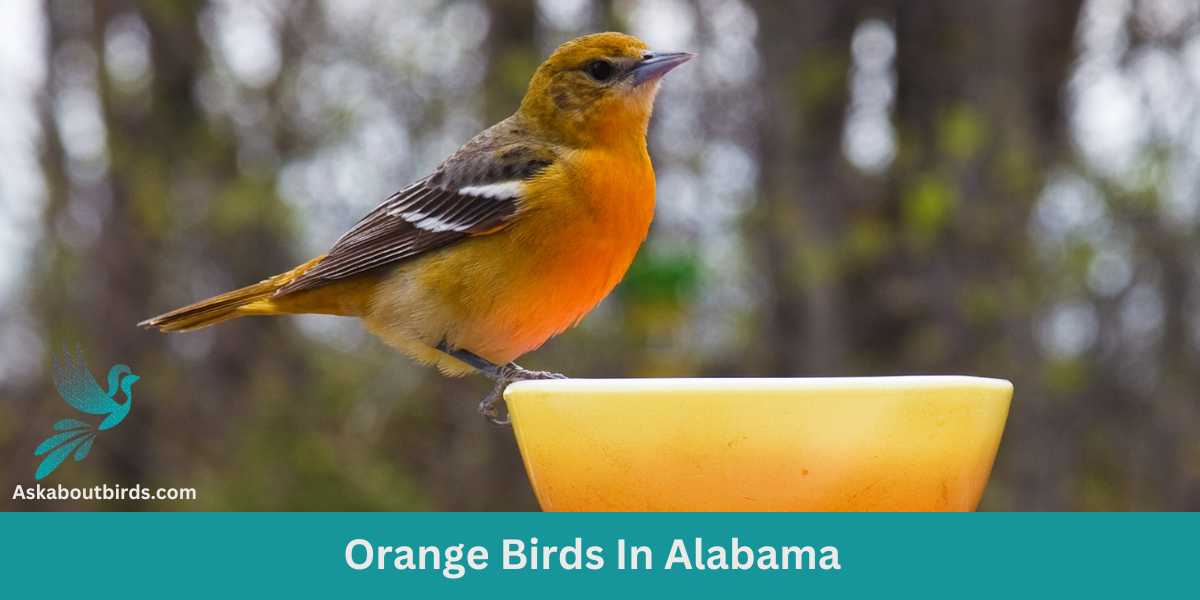Alabama, rich with a diverse range of ecosystems, is home to a myriad of bird species, including some incredibly vibrant orange-feathered birds.
Our guide, spotlighting 8 of the most vivid orange birds in Alabama, aims to aid in easy identification and add a colorful twist to your birdwatching experiences. With an accompanying free photo guide, it’s time to enrich your knowledge of Alabama’s feathery residents.
Orange Birds Found In Alabama
Alabama is home to a variety of birds, some of which sport beautiful orange plumage. Here are the common species:
Northern Cardinal


| Feature | Measurement |
|---|---|
| Scientific Name | Cardinalis cardinalis |
| Length | 8.3 – 9.1 in |
| Wingspan | 9.8 – 12.2 in |
| Weight | 1.19 – 2.29 oz |
The Northern Cardinal is an iconic North American bird, easily recognized by its vibrant color and melodious song.
Appearance: Male Northern Cardinals are a brilliant scarlet red, while females display a more subdued reddish olive. Both sexes have a distinctive black ‘mask’ on their face around the bill and a pointed crest on their head. The bird’s beak is robust, cone-shaped, and bright orange in color.
Diet: Northern Cardinals are primarily granivorous, with a diet largely consisting of seeds and grains. They also eat fruits and insects. These birds typically feed off the ground and are frequent visitors to bird feeders.
Reproduction: Northern Cardinals are monogamous, and a pair will breed together for life. The female typically builds a well-hidden nest in a dense thicket or shrub. She lays 2-5 eggs per clutch, which she incubates for around two weeks.
Baltimore Oriole


| Feature | Measurement |
|---|---|
| Scientific Name | Icterus galbula |
| Length | 6.7–8.7 in |
| Wingspan | 9.1–12.6 in |
| Weight | 22.3-42 g |
The Baltimore Oriole is a stunning bird, best known for its vibrant coloration and its rich, whistling song.
Appearance: The male Baltimore Oriole is notable for his bright orange and black plumage and black and white wing bars, a stark contrast to the more muted yellow-brown coloration of the female. Both sexes, however, have long pointed bills and white bars on their wings.
Diet: Baltimore Orioles have a diverse diet that includes insects, fruits, and nectar. Their preference for sweet juices and fruit pulp often brings them to backyard feeders offering oranges and jelly.
Reproduction: The female Baltimore Oriole is responsible for building the distinctive hanging nest, often woven together from fine materials like hair and grass. These nests are usually high in trees to avoid predators. The female lays 3-7 eggs, which are incubated for about two weeks.
Summer Tanager


| Feature | Measurement |
|---|---|
| Scientific Name | Piranga rubra |
| Length | 6.7 in |
| Wingspan | 28 to 30 cm |
| Weight | 29 g |
The Summer Tanager is a medium-sized songbird admired for its radiant plumage and melodious song.
Appearance: Male Summer Tanagers are an impressive bright red, while females and juveniles present a softer, yellow-orange color. Both genders have a large, slightly hooked bill and relatively short tail.
Diet: Summer Tanagers primarily feed on insects, including bees and wasps, which they catch in flight or pick off vegetation. They are also known to eat fruits and berries, making them helpful in controlling pest populations and seed dispersal.
Reproduction: The female Summer Tanager builds a loose, shallow cup-shaped nest out of twigs and grass, usually hidden in the foliage of trees. The female typically lays 3-5 eggs, which she will incubate for about two weeks.
Scarlet Tanager


| Feature | Measurement |
|---|---|
| Scientific Name | Piranga olivacea |
| Length | 6.3 to 7.5 in |
| Wingspan | 9.8 to 11.8 in |
| Weight | 23.5 to 38 g |
The Scarlet Tanager is a strikingly colorful bird known for its brilliant plumage and distinctive song.
Appearance: Male Scarlet Tanagers are notable for their vibrant scarlet bodies contrasted with black wings and tail, making them one of the most intensely colored birds. Females and juveniles, on the other hand, have a subdued olive-yellow body color with darker wings and tail.
Diet: The diet of the Scarlet Tanager is largely made up of insects, including beetles, cicadas, aphids, and others. They are adept flycatchers, seizing insects in mid-air or picking them off foliage. They also consume fruits and berries, especially during migration and in their winter habitats.
Reproduction: The female Scarlet Tanager builds a cup-shaped nest using twigs, rootlets, and grass, typically well-hidden in the dense foliage of trees. She lays 3 to 5 eggs and incubates them for about two weeks.
Eastern Towhee

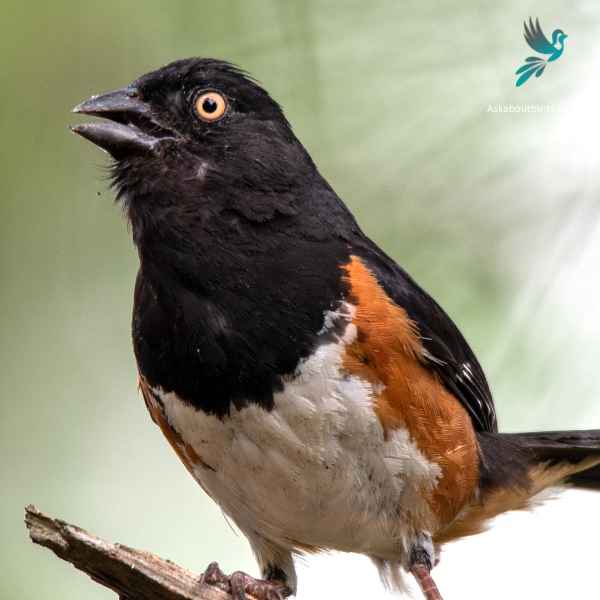
| Feature | Measurement |
|---|---|
| Scientific Name | Pipilo erythrophthalmus |
| Length | 6.8 to 9.1 in |
| Wingspan | 7.9–11.8 in |
| Weight | 32 to 53 g |
The Eastern Towhee is a distinctive songbird known for its unique calls and eye-catching coloration.
Appearance: Male Eastern Towhees are characterized by a striking combination of a black head, back and tail, contrasting with a white belly and rufous flanks. Females sport similar patterns but instead of black, they have a rich brown color. Both genders have red eyes, lending a special charm to their overall appearance.
Diet: Eastern Towhees primarily feed on a variety of insects, seeds, and berries. Their diet is quite diverse, taking advantage of seasonal offerings, which includes beetles, caterpillars, spiders, acorns, grass seeds, and various fruits and berries.
Reproduction: Eastern Towhees build their nests on or near the ground, often in a shrub or a small tree. The female lays around 3-5 eggs and takes the primary role in incubating them over about 12-13 days.
American Robins


| Feature | Measurement |
|---|---|
| Scientific Name | Leptotila plumbeicep |
| Length | 10.6-11.8 in |
| Wingspan | — |
| Weight | 160-200 g |
The American Robin is a widely recognized bird species known for its melodious song and early bird tendencies.
Appearance: American Robins are medium-sized birds with a distinctive appearance. Both males and females sport a gray to brown back and a warm red to orange breast and belly and gray wings. They also have a characteristic white eye-ring and a black head, but males are usually darker than females.
Diet: American Robins have a diverse diet that changes depending on the season. In summer, they feed heavily on earthworms, beetles, and other invertebrates, which they catch on the ground. During winter, they mostly eat fruits and berries.
Reproduction: American Robins usually build their nests in trees or shrubs, but they are also known to nest on human-made structures. The female lays a clutch of about 3 to 5 eggs, which she incubates for about 12 to 14 days.
Red Crossbill
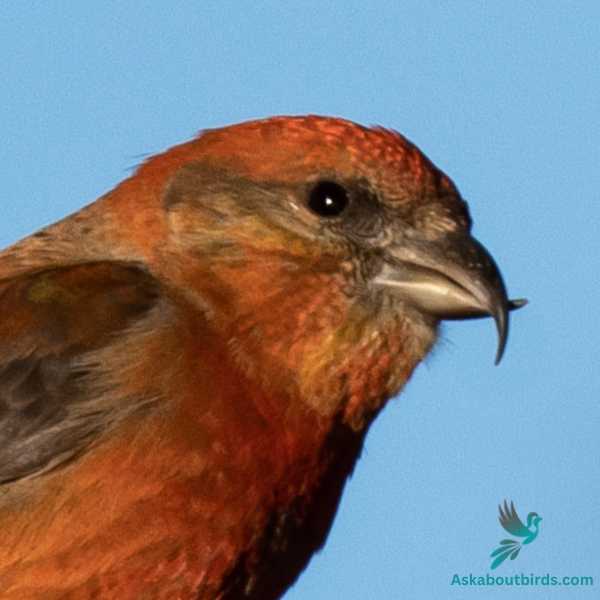

| Feature | Measurement |
|---|---|
| Scientific Name | Loxia curvirostra |
| Length | 20 cm |
| Wingspan | 27–29 cm |
| Weight | 40-53 g |
The Red Crossbill is a peculiar bird species, celebrated for its unique beak structure and vibrant coloration.
Appearance: Red Crossbills are named for their distinctive crossed mandibles, which are adapted to extracting seeds from conifer cones. Male Red Crossbills are usually bright red or orange, while females and juveniles are greenish-yellow. All have dark wings and notched tails.
Diet: The diet of the Red Crossbill is primarily composed of conifer seeds, their unique beak allowing them to access these seeds with ease. This diet includes seeds from pine, spruce, and other types of coniferous trees. They are also known to consume some insects.
Reproduction: Red Crossbills are known for their flexible breeding season, which can occur any time of the year when there is an abundance of food. They typically nest in conifers, where the female lays a clutch of 3 to 4 eggs.
Orchard Oriole
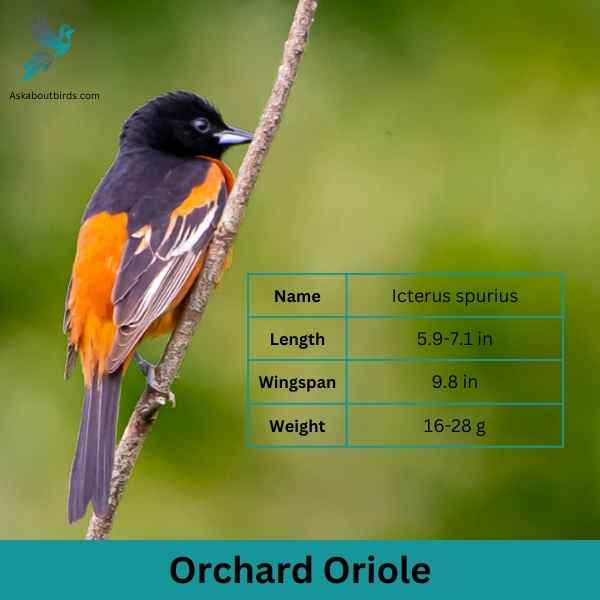
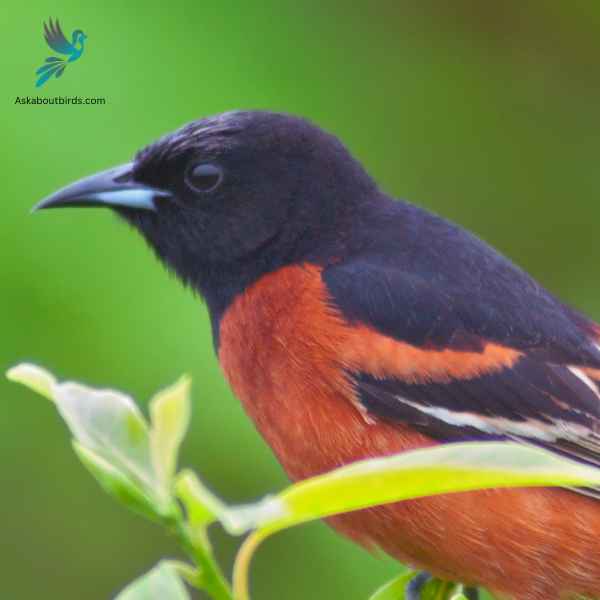
| Feature | Measurement |
|---|---|
| Scientific Name | Icterus spurius |
| Length | 5.9-7.1 in |
| Wingspan | 9.8 in |
| Weight | 16-28 g |
The Orchard Oriole is a small songbird noted for its distinctive coloration and melodic song.
Appearance: Male Orchard Orioles are a striking sight with their dark chestnut body and black head and black and white wings, while females and immature males are olive-green and feature a yellowish underpart. The species is often recognized by its slender body and pointed bill.
Diet: The diet of the Orchard Oriole consists primarily of insects, fruits, and nectar. They are adept at catching insects mid-air and are also known to sip nectar from flowers, aiding in pollination. When fruits are in season, they make up a substantial portion of the bird’s diet.
Reproduction: Orchard Orioles often nest in open woodlands and orchards, hence their name. The female is responsible for building the nest, typically choosing a location in a tree or shrub. The female lays a clutch of 4 to 6 eggs, which she incubates for about two weeks.
Where to Spot Alabama’s Orange Birds
Alabama’s rich biodiversity and varying ecosystems provide exceptional opportunities for birdwatching, particularly for those interested in spotting the vivid orange birds. Here are the top locations in the state known for the greatest diversity of bird species:
- Dauphin Island: Renowned as one of the top birding spots in the country, Dauphin Island hosts a bird sanctuary that serves as a crucial stopover for migratory birds, offering the chance to spot a variety of orange-colored species.
- Wheeler National Wildlife Refuge: Covering over 35,000 acres, this refuge near Decatur is home to an impressive assortment of birds, including some orange varieties. The observation tower provides an excellent vantage point for birdwatching.
- Bankhead National Forest: This extensive forest in Northwestern Alabama is a haven for diverse bird species, including the colorful orange ones. Its mixed hardwood and pine forests offer a rich habitat, and the extensive trail system allows close access.
- Cahaba River National Wildlife Refuge: Famous for its unique shoal lilies, this refuge also provides habitats for a variety of orange birds. The clean water and healthy riparian ecosystem draw bird enthusiasts from all over.
- Gulf State Park: Located on the coast, this park offers a blend of beach, marsh, and forest habitats, making it an ideal spot to observe a wide array of bird species. The birding trail and observation platforms provide perfect opportunities for spotting orange birds.
| State’s Orange Birds | Best Spots to See Orange Birds |
|---|---|
| Florida’s Orange Birds | Everglades National Park, Merritt Island National Wildlife Refuge, Corkscrew Swamp Sanctuary |
| Georgia’s Orange Birds | Okefenokee National Wildlife Refuge, Cochran Shoals, Savannah National Wildlife Refuge |
| Tennessee’s Orange Birds | Great Smoky Mountains National Park, Radnor Lake State Park, Reelfoot Lake State Park |
| Mississippi’s Orange Birds | Noxubee National Wildlife Refuge, Gulf Islands National Seashore, St. Catherine Creek NWR |
FAQs on Orange Bird Species Found in Alabama
In Alabama, the vibrant House Finch, with its hues of light orange, is a common sight. Akin to Yellow Birds and Yellow Rumped Warblers, they often visit bird feeders, munching on seeds alongside other birds like Blue Jays and Carolina Chickadees. In the open woods, one can also spot the Brown Headed Cowbird, another orange avian resident. Alabama, home to many bird species, including the State Bird, the Yellowhammer, attracts bird enthusiasts who revel in observing the daily routines of these creatures, from large flocks of Barn Swallows to shy, solitary Ruby Throated Hummingbirds. orange breast
How many bird species in Alabama?
Alabama is a bird watcher’s paradise, boasting over 430 bird species. These species range from the common Blue Jay (spotted by its bright blue feathers), the yellow rumped warbler (known for its bright yellow bird at the bird feeder) to the more unique Bald Eagle. Among the medium-sized birds, the Red-Bellied Woodpecker and Red-Headed Woodpecker are frequent sights.
Alabama’s diverse habitats, from Rocky Mountains to open woods, attract a variety of bird species including the Mourning Dove, American Goldfinch, and the state’s official bird, the Yellowhammer, also known as the Northern Flicker. In the winter months, one might even spot the Red-Tailed Hawk or the elusive, shy birds such as the Brown Thrasher and Green Heron. Whether in deciduous woods or observing from backyard feeders, bird enthusiasts can enjoy the colorful variety Alabama’s avian world offers.
What kind of bird is orange in color?
In Alabama, one common backyard birds that visits bird feeders that boasts an orange color is the Northern Flicker. This medium-sized bird is often seen in deciduous or mixed woods, and their distinct coloration makes them a delight for bird watching enthusiasts. The male bird is especially vibrant during the mating season.
What is the rust colored bird in Alabama?
The Brown Thrasher is a rust-colored bird commonly seen in Alabama. This bird is about the size of a common backyard bird and can often be found visiting backyard feeders, especially those offering sunflower seeds, a favorite bird food for many species. The Brown Thrasher can be distinguished by its long tail and curved beak.
What bird has a bright orange beak in Alabama?
The bird with a bright orange beak you may see in Alabama is likely the Eastern Bluebird. This bird is notable for its blue plumage, contrasting against its bright orange beak. Eastern Bluebirds are frequent visitors to bird feeders, where they enjoy a meal of black oil sunflower seeds.
What birds are light orange?
House Finches are often light orange, and they’re among the most common birds you can spot in Alabama year-round. Both the male and female birds have a lightly colored underbelly. The male bird is often more brightly colored than the female, especially during breeding season. They are frequent visitors to bird feeders and particularly enjoy sunflower seeds. They are a delight for those with bird feeders, contributing to the variety of other bird species you can enjoy watching.

